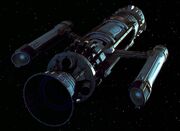m (Bot: Automated text replacement (-Subspace communications +Subspace communications) !!wikia-credits fix!!) |
Pseudohuman (talk | contribs) mNo edit summary |
||
| (19 intermediate revisions by 12 users not shown) | |||
| Line 1: | Line 1: | ||
| + | [[File:Phoenix space.jpg|thumb|''[[Phoenix]]'', [[Earth]]'s first ship to reach the speed of light]] |
||
| − | The '''speed of light''', also referred to as '''light speed''', or the '''warp threshold''', is the velocity that [[light]] travels in a vacuum. This constant, usually denoted '''''c''''', is exactly 299,792,458 |
+ | The '''speed of light''', also referred to as '''light speed''', or the '''warp threshold''', is the velocity that [[light]] travels in a [[vacuum]]. This constant, usually denoted '''''c''''', is exactly 299,792,458 meters/second or 186,282 miles per second in imperial units. The speed of light was equivalent to the speed of [[Warp factor|warp factor 1]]. ({{ENT|First Flight}}, ''display graphic'') |
| − | |||
| + | ==History== |
||
The ''[[Phoenix]]'', piloted by [[Zefram Cochrane]], was [[Earth]]'s first [[starship|ship]] to be successfully equipped with a '''faster-than-light propulsion''' system. ({{film|8}}) |
The ''[[Phoenix]]'', piloted by [[Zefram Cochrane]], was [[Earth]]'s first [[starship|ship]] to be successfully equipped with a '''faster-than-light propulsion''' system. ({{film|8}}) |
||
| − | The ability to travel faster than light |
+ | The ability to travel faster than light was considered to be a major technological milestone in a species' development. The {{Federation}} typically subdivided civilizations and cultures on whether they had developed technology to exceed the speed of light. The species that had not yet achieved the level of technology required were placed in the [[pre-warp civilization]] category. The [[Vulcan]] custom of not making [[first contact]] with pre-warp civilizations was later on adopted by the Federation as well. ({{ENT|Civilization}}; {{TNG|First Contact}}) |
| − | |||
| ⚫ | |||
| ⚫ | |||
| ⚫ | |||
| ⚫ | |||
| ⚫ | |||
| − | == |
+ | ==Appendices== |
| ⚫ | |||
| ⚫ | |||
| ⚫ | |||
| ⚫ | |||
| + | ====Propulsion==== |
||
| ⚫ | |||
| − | == |
+ | ===Background information=== |
| − | According to |
+ | According to ''[[Star Trek: The Next Generation Technical Manual]]'', (pp. 54 & 55) in the context of a [[warp drive]], under the conditions where the total amount of [[subspace distortion]] in all the energy layers put together, that form a [[warp field]] around a ship, equal [[Cochrane (unit)|1 cochrane]] and this accelerates the ship to the speed of [[Warp factor|warp factor 1]], or the speed of light, approximately [[Joule|20 gigajoules]] of energy are required to create the warp field, and only 200 megajoules to maintain it. Depending on a multitude of spatial conditions, the level of cochranes required for any given warp factor varies. |
| + | ===External link=== |
||
| − | Modern physics experiments have shown that the "phase velocity" of laser light can exceed c, and some observed phenomena in quantum mechanics also exceed c. However, practical applications of these experiments do not exist because it can be shown that no information or particles can actually be transmitted faster than light by those methods. Other than the information cited to {{film|8}}, this information is not [[canon]], but is considered to come from a Memory Alpha permitted [[Memory Alpha:Canon policy|resource]]. |
||
| + | * {{wikipedia}} |
||
| − | According to [[Albert Einstein]]'s theory of relativity, though, faster than light travel is not possible because when an object accelerates most of its energy goes into increasing |
||
| − | its own mass, so at speeds approaching c, all of its energy goes into this process, therefore rendering faster than light travel impossible through conventional means. |
||
[[de:Lichtgeschwindigkeit]] |
[[de:Lichtgeschwindigkeit]] |
||
Revision as of 14:30, 29 January 2014

The speed of light, also referred to as light speed, or the warp threshold, is the velocity that light travels in a vacuum. This constant, usually denoted c, is exactly 299,792,458 meters/second or 186,282 miles per second in imperial units. The speed of light was equivalent to the speed of warp factor 1. (ENT: "First Flight", display graphic)
History
The Phoenix, piloted by Zefram Cochrane, was Earth's first ship to be successfully equipped with a faster-than-light propulsion system. (Star Trek: First Contact)
The ability to travel faster than light was considered to be a major technological milestone in a species' development. The United Federation of Planets typically subdivided civilizations and cultures on whether they had developed technology to exceed the speed of light. The species that had not yet achieved the level of technology required were placed in the pre-warp civilization category. The Vulcan custom of not making first contact with pre-warp civilizations was later on adopted by the Federation as well. (ENT: "Civilization"; TNG: "First Contact")
In 2254, the USS Enterprise encountered a faked distress call from SS Columbia created by the Talosians. The signal was keyed to register on sensors as an unknown object on a collision course which traveled with the speed of light. (TOS: "The Cage")
Appendices
Faster-than-light technology
Subspace communications
Propulsion
- See: Propulsion
Background information
According to Star Trek: The Next Generation Technical Manual, (pp. 54 & 55) in the context of a warp drive, under the conditions where the total amount of subspace distortion in all the energy layers put together, that form a warp field around a ship, equal 1 cochrane and this accelerates the ship to the speed of warp factor 1, or the speed of light, approximately 20 gigajoules of energy are required to create the warp field, and only 200 megajoules to maintain it. Depending on a multitude of spatial conditions, the level of cochranes required for any given warp factor varies.
